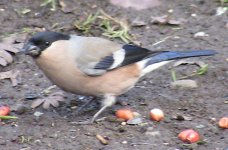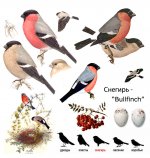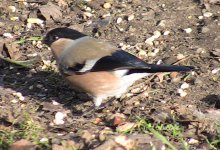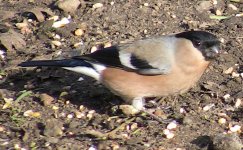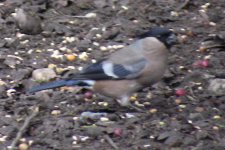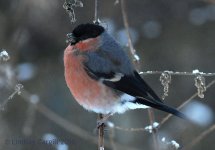-
Welcome to BirdForum, the internet's largest birding community with thousands of members from all over the world. The forums are dedicated to wild birds, birding, binoculars and equipment and all that goes with it.
Please register for an account to take part in the discussions in the forum, post your pictures in the gallery and more.
You are using an out of date browser. It may not display this or other websites correctly.
You should upgrade or use an alternative browser.
You should upgrade or use an alternative browser.
Ageing....male Bullfinch? (1 Viewer)
- Thread starter KenM
- Start date
More options
Who Replied?You would expect 1st winter birds to look like adults by now. Post juvenile starts around late August to mid October and the moult is generally finished between October and December. They tend to leave a few greater covers and the carpal coverts however this isnt always easy to see in the field.
The full post juvenile moult takes around 8 weeks.
The full post juvenile moult takes around 8 weeks.
Motmot
Eduardo Amengual
Jon Turner
Well-known member
I ringed a female this week which was clearly a 1st -winter with 3 or 4 buff greater coverts. So fledged this year.
KenM
Well-known member
Thanks Guys!....
This image was taken on 25th November...being the first 'immature' male Bullfinch that I'd ever laid eyes on! Am struggling to come to terms with this decades long omission...but am putting it down to the fact that although having seen scores over the years! I've never observed Bullfinches during this 8 week transient period! Also in my neck of the woods they have always been shy and retiring..and over the last few years..almost
non-existent! :t:
This image was taken on 25th November...being the first 'immature' male Bullfinch that I'd ever laid eyes on! Am struggling to come to terms with this decades long omission...but am putting it down to the fact that although having seen scores over the years! I've never observed Bullfinches during this 8 week transient period! Also in my neck of the woods they have always been shy and retiring..and over the last few years..almost
non-existent! :t:
Attachments
bombycilla
Well-known member
Thanks Guys!....
This image was taken on 25th November...being the first 'immature' male Bullfinch that I'd ever laid eyes on! [/I]
Hi Ken,
The bird in your photograph is a female Bullfinch, possibly an adult as there is no obvious moult limit in the greater coverts, though it is hard to determine this with field photographs (and some 1st year birds replace all of them). Notice the stonking grey alulal feathers on your bird. These would be an adult trait as juv alula are brown - however, not all adult bullies seem to show these very grey feathers. They are maybe like Greenfinch where the alula get brighter (and greyer) with age.
As a ringer, if a 1st year bully had a black 'cap' I would age it as a "3" (before Jan 1st) meaning it was born that year. If it had no 'cap' it would be aged as a 3J, the J standing for juvenile plumage. If a bullfinch has a black cap it would be considered to have pretty much completed it's post-juvenile moult.
I have been on a bit of a Bullfinch journey myself recently ! http://pinemuncher.blogspot.com/2010/12/what-load-of-bull.html
Cheers,
LC
Attachments
KenM
Well-known member
LC Hi,
I found your comments quite interesting!..I've rustled up a few more images of non-adult males, and look forward to your assessment... and, would I be right in assuming that all non-adult males, do not have a grey alula... and that adult females can have a rose tint to the breast and flanks as shown below?
cheers
I found your comments quite interesting!..I've rustled up a few more images of non-adult males, and look forward to your assessment... and, would I be right in assuming that all non-adult males, do not have a grey alula... and that adult females can have a rose tint to the breast and flanks as shown below?
cheers
Attachments
bombycilla
Well-known member
LC Hi,
I found your comments quite interesting!..I've rustled up a few more images of non-adult males, and look forward to your assessment... and, would I be right in assuming that all non-adult males, do not have a grey alula... and that adult females can have a rose tint to the breast and flanks as shown below?
cheers
Hi Ken,
All those look like females to me - females can appear as pink/buff colour but nowhere as bright as the males. Are left and middle the same bird ? Not sure about the grey alula thing and whether this is an adult trait or not, but I suspect it would be as juv feathers are brown edged - I am trying to find out about that myself but can find no references to it not even in the Ringers Bible or Jenni and Winkler's Moult book ! Some juvenile birds can have paler alula but I have (so far) not seen any photos on web of obvious juvs with stonking grey alula like yours has.
Did find THIS cracking male though (4th one down, Hessle East Yorkshire). Sometimes a few outer primary coverts can be grey it seems also. The intruiging thing is that Ruskie plate I attached in my previous post has two specimens where there is no black on the greater coverts at all - they are grey as per lesser and median coverts. Can't find anything anywhere about that.
Cheers,
Lindsay
Last edited:
bombycilla
Well-known member
Hi Ken,
This is a first winter male I photographed last week. Much pinker (Andrex toilet roll pink ? !) than your examples. This bird was born this year and this I would say is a typicalish post-juvenile moult, though it has only renewed the inner most greater covert. Also note how extensive grey the scapulars and mantle is compared to your birds - this is a male trait.
Hope this helps,
Best
Lindsay
This is a first winter male I photographed last week. Much pinker (Andrex toilet roll pink ? !) than your examples. This bird was born this year and this I would say is a typicalish post-juvenile moult, though it has only renewed the inner most greater covert. Also note how extensive grey the scapulars and mantle is compared to your birds - this is a male trait.
Hope this helps,
Best
Lindsay
Attachments
Last edited:
KenM
Well-known member
Lindsay Hi,
I have almost zero experience of juv/imm.Bullfinch! That said...over the years I've seen a reasonable number of adults, and all my observations of the female gender have been distinctly darker and greyer (obviously so!). I entertain the idea that...had I seen a bird as depicted in my shots...I would have remembered the 'pinky' wash to the underparts..what do others think?
I have almost zero experience of juv/imm.Bullfinch! That said...over the years I've seen a reasonable number of adults, and all my observations of the female gender have been distinctly darker and greyer (obviously so!). I entertain the idea that...had I seen a bird as depicted in my shots...I would have remembered the 'pinky' wash to the underparts..what do others think?
Frenchy
Well-known member
Here's an even pinker female Bullfinch: http://www.birdguides.com/iris/pictures.asp?v=1&f=275868
Maybe they get pinker as they get older, or maybe its just individual variation.
Maybe they get pinker as they get older, or maybe its just individual variation.
bombycilla
Well-known member
Lindsay Hi,
I have almost zero experience of juv/imm.Bullfinch! That said...over the years I've seen a reasonable number of adults, and all my observations of the female gender have been distinctly darker and greyer (obviously so!). I entertain the idea that...had I seen a bird as depicted in my shots...I would have remembered the 'pinky' wash to the underparts..what do others think?
Hi Ken,
Your birds (possibly all the same individual ?) are defintely female Bullfinches and in 'adult-like' plumage rather than juvenile plumage - juvenile plumage would mean no black cap as I mentioned in an earlier post, or showing obvious signs of post-juvenile moult as the adult type cap and body feathers come in.
If you scroll so your 3 pics are in view on screen with the Russian Plate of Bullfinches that I attached you will see the colour tones of your birds match exactly those on the plate (for female). The other good feature is the extensive grey mantle/sacps that the male has whereas female has more of a wash or shawl of grey (as yours has).
Frenchy is right about older hens turning more 'male' like in plumage - I have ringed old female greenfinches that are bright green, and they say it happens with crossbills though I have never seen this in the hand or in the field. However, your bullies are not nearly intensely red-pink enough to be considered males.
Birding is always about gaining experience and I too have recently learned a hell of a lot about Bullfinch calls eg. how variable they are, so it looks like we have both been gaining experience of the species, and that is surely a good thing !
Cheers,
Lindsay
KenM
Well-known member
Lindsay Hi,
Very interesting!....all my supplied images are of the same bird!....also present at the site on the day....were 2 'typical' darker adult females, another bird marginally darker than the original subject, plus two adult males.
In retrospect...I wish I'd imaged the darker birds...as they looked quite different!...definitely a preponderance of females within that particular group.
Clearly it would appear...that there was an age difference (cosmetically)between the 4 females..so much so, that I would have expected this 'difference' to have warranted mentioning in text...within quality field guides.
cheers
Very interesting!....all my supplied images are of the same bird!....also present at the site on the day....were 2 'typical' darker adult females, another bird marginally darker than the original subject, plus two adult males.
In retrospect...I wish I'd imaged the darker birds...as they looked quite different!...definitely a preponderance of females within that particular group.
Clearly it would appear...that there was an age difference (cosmetically)between the 4 females..so much so, that I would have expected this 'difference' to have warranted mentioning in text...within quality field guides.
cheers
Users who are viewing this thread
Total: 2 (members: 0, guests: 2)




